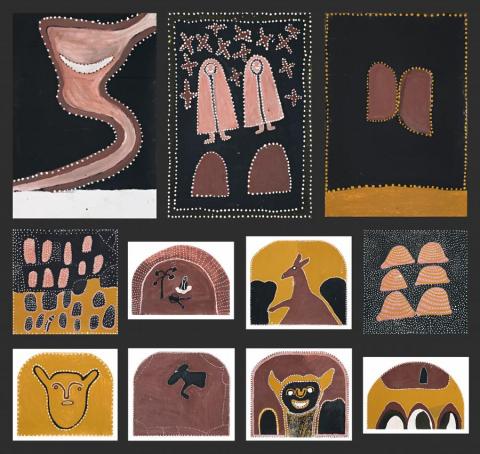17 DANCE BOARDS AND TWO MASKS RELATING TO THE GURIRR GURIRR (KRILL KRILL) CYCLE
Hector Chundaloo Jandany (and Others)
Dance Boards: natural earth pigments on plywood
Masks: natural earth pigments on cardboard
various sizes
each inscribed verso: artist's name, Waringarri Aboriginal Arts cat. number, and the text “M.C.A. NOV 96”
Waringarri Aboriginal Arts, Kununurra
Private collection, Queensland
Gurirr Gurirr: Visual Art and Performance by Artists from Warmun and Doon Doon, W.A., Museum of Contemporary Art, Sydney, November 1996
It is within the Gurirr Gurirr ceremony and accompanying songs, imagery and choreography that we find the genesis of the school of painting now commonly known as the Warmun or East Kimberley style. Composed by the late Rover Thomas in the early 1970s, the thirty–one verses of the Gurirr Gurirr emerged at a time of decline in ceremonial practices that followed the exclusion of stockmen such as Thomas from their traditional lands. The song cycle issued from a period of upheaval, informed as much by a response to the catastrophic consequences of European settlement in the Kimberley as it is by country and ancestral law. The Gurirr Gurirr heralded a great cultural revival and the beginnings of a movement that was to transform Australian art.
Revealed to Rover Thomas through a series of visions and dreams, the Gurirr Gurirr chronicles the spectral odyssey undertaken by the spirit of Thomas's classificatory mother who was killed in a car accident during the torrential rains of Cyclone Tracy. The song cycle follows her journey across the Kimberley, accompanied by a companion spirit, Jimpi, who was later replaced by Manginta. Throughout their voyage several sacred and historically important sites are visited. The ceremony culminates in the spirit 's witnessing the destruction of Darwin by the Rainbow Serpent Unggud manifesting as the cyclone. Interpreted by many Elders across the Kimberley as a portent, a number of ceremonies were developed about the cyclone and performed as acts of cultural affirmation.
In the Gurirr Gurirr, painted boards, each relating to an element of the cycle, are revealed sequentially accompanied by songmen and a chanting chorus. Painted on thread–crosses or palga, Rover Thomas instructed and supervised their creation though did not paint any of the boards in the first performances of the Gurirr Gurirr. Depicting episodes and places in the dreaming, some participants wear masks representing the companion spirits and act as intermediaries between the performers and audience. This group of boards and masks were made by artists from Warmun and Doon Doon and were used in a performance of the Gurirr Gurirr at the Museum of Contemporary Art in November of 1996.
